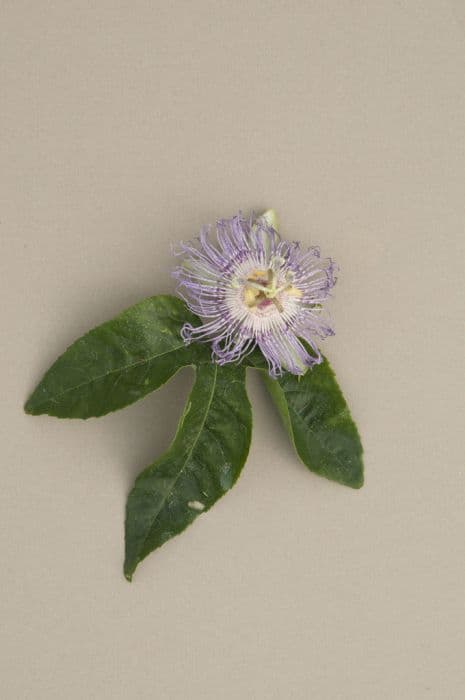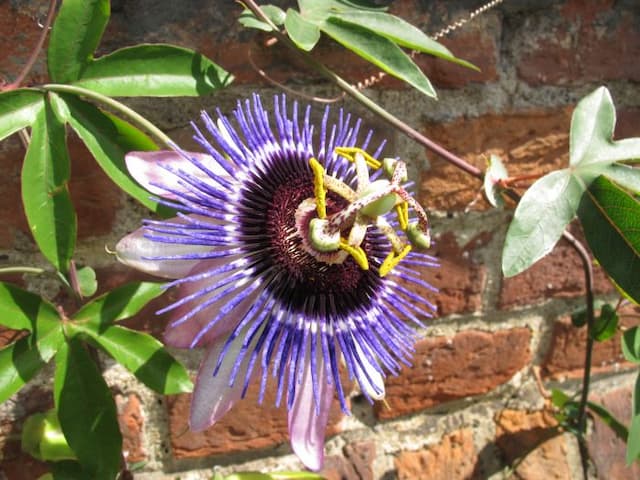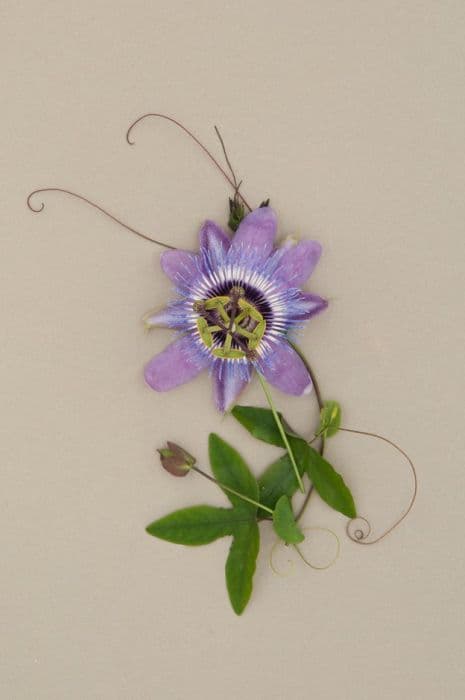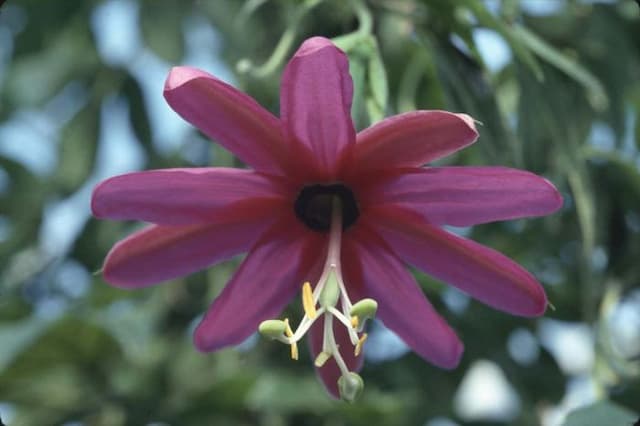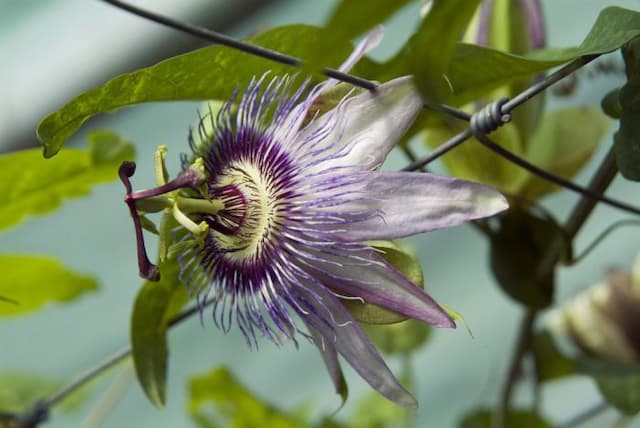Winged Passion Flower Passiflora alata (F)

ABOUT
Passiflora alata, commonly known as the winged-stem passionflower, is a strikingly beautiful climbing vine with distinctive flowers and foliage. Its flowers are particularly showy and complex, typically displaying a rich array of colors. Most notably, the blooms feature a set of prominent, crimson petals that are complemented by a coronet of purple and white filaments, which create an almost halo-like appearance around the central parts of the flower. These filaments are arranged in a concentric circle, giving a fringed or feathery look. The foliage of the winged-stem passionflower is equally attractive, with dark green leaves that are glossy and oval-shaped, often with a pointed tip. The edges of the leaves are smooth and sometimes exhibit a slight undulation, adding to the plant's ornamental qualities. Adding to its appeal, coiled tendrils emerge from the plant, which it uses for support and climbing on nearby structures or other plants. The fruit of the winged-stem passionflower, which is edible, is oval and produced after the flowers are pollinated. The skin of the fruit is typically bright to deep yellow when ripe, and on the inside, it contains a pulpy flesh filled with numerous small seeds. The scent of the flower is pleasing and aromatic, adding a sensory dimension to its appearance. This combination of features makes the winged-stem passionflower a captivating presence in any garden or tropical landscape.
About this plant
 Names
NamesFamily
Passifloraceae
Synonyms
Winged Passion Flower, Fragrant Granadilla, Maracuja De Refresco, Scarlet Passion Flower, Red Passion Flower
Common names
Passiflora alata Curtis, Passiflora coccinea Vell., Passiflora mollissima Kunth, Tacsonia mollissima Kunth.
 Toxicity
ToxicityTo humans
Passiflora alata, commonly known as Winged-Stem Passionflower, is not considered highly toxic to humans. There are no significant reports of poisoning upon ingestion of this plant. Occasionally, some individuals may experience mild discomfort such as nausea or stomach upset if they consume large amounts of the plant, but this is not common. The fruits of Passiflora alata are edible and are often used in traditional medicine and as flavorings. However, as with any plant material, sensitive individuals might have an allergic reaction or experience mild gastrointestinal symptoms.
To pets
Winged-Stem Passionflower, or Passiflora alata, is also not known to be highly toxic to pets, such as dogs and cats. Pets may sometimes chew on the leaves or flowers of the plant but typically do not suffer from severe poisoning. Some plants in the Passiflora family contain compounds that may cause mild gastrointestinal upset such as vomiting or diarrhea if ingested in large quantities by pets, so it is generally recommended to keep an eye on your pets around this plant and prevent them from consuming large amounts. However, serious toxicity is not commonly reported. If a pet does ingest a significant amount of the plant and shows adverse reactions, it is advisable to seek veterinary assistance.
 Characteristics
CharacteristicsLife cycle
Perennials
Foliage type
Evergreen
Color of leaves
Green
Flower color
Red
Height
10 feet (3 meters)
Spread
6 feet (1.8 meters)
Plant type
Climber
Hardiness zones
11
Native area
South America
Benefits
 General Benefits
General Benefits- Ornamental Value: Passiflora alata, commonly known as the "Winged-Stem Passion Flower," is a popular ornamental plant due to its strikingly beautiful flowers, which add visual interest and exotic appeal to gardens and landscapes.
- Ecological Support: It serves as a host plant for several species of butterflies, providing a habitat and food source for their caterpillars, thus supporting local biodiversity.
- Edible Fruit: The plant produces edible fruits, known as passion fruit, which are consumed fresh or used in juices, desserts, and culinary preparations for their tropical flavor.
- Shade Provider: With its vigorous climbing growth habit, Passiflora alata can be used to create natural shaded areas in gardens, offering relief from the sun and reducing the need for constructed shade covers.
- Cultural Significance: The unique floral structure of the Winged-Stem Passion Flower has religious and cultural significance in many regions, being associated with symbols of the Passion of Christ, hence its name.
- Privacy Screen: When grown on fences or trellises, the plant can serve as an effective and attractive privacy screen, creating a living wall that blocks unwanted views.
- Wildlife Attraction: The flowers of Passiflora alata attract a variety of pollinators, including bees, hummingbirds, and bats, thereby contributing to the pollination of other plants in the surrounding area.
- Fragrance: The blooms of the Winged-Stem Passion Flower might emit a subtle fragrance, contributing a pleasant scent to the area where it's grown.
 Medical Properties
Medical Properties- Anxiolytic: Passiflora alata is traditionally used for its sedative and calming effects, which may help in reducing anxiety symptoms.
- Insomnia Treatment: The plant contains compounds that are thought to have sleep-inducing properties, helping individuals with sleep disorders such as insomnia.
- Antioxidant: It possesses antioxidant properties due to the presence of flavonoids and other compounds, which can help in protecting the body from oxidative stress.
- Analgesic: Passiflora alata may have pain-relieving properties, making it useful in managing mild pain conditions.
- Anti-inflammatory: It may help in reducing inflammation and is sometimes used in treating conditions associated with inflammation.
- Antispasmodic: The plant is believed to help relieve muscle spasms and cramps, which can be beneficial in gastrointestinal and menstrual discomfort.
 Air-purifying Qualities
Air-purifying QualitiesThis plant is not specifically known for air purifying qualities.
 Other Uses
Other Uses- As an ornamental plant: Passiflora alata, commonly known as winged-stem passion flower, is often cultivated for its striking flowers and unique foliage to enhance garden aesthetics.
- In perfumery: The flower's intense and exotic fragrance can be used in the manufacture of perfumes and scented oils.
- In religious symbolism: The flower is used in Christian symbolism to represent the Passion of Christ, with various parts of the plant symbolizing aspects of the Crucifixion story.
- As a natural dye: The petals and fruit can be used to extract pigments for natural dyes in textile applications.
- In butterfly gardens: Passiflora alata serves as a host plant for various butterfly species, thus playing a role in supporting butterfly populations.
- As a learning tool: The complex structure of the flower is used in botanical studies to teach about plant morphology and pollination mechanisms.
- In crafting: Dried parts of the plant, such as the flowers and leaves, can be used in decorative crafts and potpourri.
- As a climbing structure: The vine can be used to create living screens or green walls, providing privacy and aesthetic appeal in landscaping.
- In food presentation: The vibrant flowers can be used as edible decorations to enhance the visual appeal of gourmet dishes.
- As a natural insecticide: Certain compounds found in Passiflora alata leaves have been known to repel insects and could be used in the development of natural insect repellents.
Interesting Facts
 Feng Shui
Feng ShuiThe Winged-stem Passionflower is not used in Feng Shui practice.
 Zodiac Sign Compitability
Zodiac Sign CompitabilityThe Winged-stem Passionflower is not used in astrology practice.
 Plant Symbolism
Plant Symbolism- Passion: Passiflora alata, commonly known as Passion Flower, is often associated with passion and the passion of Christ due to its unique floral structure, which is said to symbolize different aspects of the crucifixion, including the crown of thorns.
- Suffering and Glory: The name "Passion Flower" encompasses the symbol of suffering (the Passion of Christ) and the hope and glory of resurrection.
- Faith: The components of the flower have been likened to the apostles and the Trinity, hence it can symbolize religious faith and spirituality.
- Peace and Calm: Its calming properties, which are also recognized in herbal medicine, give it a symbol of tranquility and peace of mind.
 Water
WaterThe Fragrant Granadilla requires consistent watering to keep the soil evenly moist but not soggy. During the growing season in spring and summer, water thoroughly once a week using about 1-2 gallons per plant, depending on the size and container. Reduce watering in the fall and winter to every 2 weeks, allowing the top inch of soil to dry out between waterings. Overwatering can lead to root rot, so it's important to have well-draining soil.
 Light
LightFor the Fragrant Granadilla, bright indirect light or filtered sunlight is ideal. A spot near an east or west-facing window where it receives some morning or late afternoon sun would be perfect. Avoid direct midday sun which can scorch the leaves, and consider using a sheer curtain to diffuse the light if necessary.
 Temperature
TemperatureThe Fragrant Granadilla thrives in warm temperatures, ideally between 68°F and 85°F. It can survive minimum temperatures of around 50°F, but growth will be slowed. Protect the plant from temperatures below 50°F and avoid sudden temperature drops which can be harmful.
 Pruning
PruningPruning the Fragrant Granadilla encourages healthy growth and flowering. Prune in early spring to shape the plant and remove any dead or overgrown vines. Light pruning can be done throughout the year to maintain its size, but the main pruning should occur when the plant is not actively flowering.
 Cleaning
CleaningAs needed
 Soil
SoilWinged passion flower thrives in well-draining, rich, loamy soil with a pH between 6.1 and 7.5. A mixture of one part peat, one part pine bark, and one part coarse sand or perlite is ideal to ensure good drainage and aeration.
 Repotting
RepottingWinged passion flower should be repotted every 2 to 3 years, or when the plant has outgrown its current pot, to replenish nutrients and accommodate root growth.
 Humidity & Misting
Humidity & MistingWinged passion flower prefers high humidity levels, ideally between 50-70%. Maintaining this range encourages healthy growth and vibrant blooms.
 Suitable locations
Suitable locationsIndoor
Place in bright, indirect light and maintain high humidity.
Outdoor
Plant in partial shade with shelter from strong winds.
Hardiness zone
10-12 USDA
 Life cycle
Life cycleThe life of Winged-Stem Passion Flower begins with seed germination, where moist, warm conditions allow the hard-coated seeds to sprout, a process which can take several weeks to months. Following germination, the seedling stage is characterized by the emergence of the primary root and initial leaves, and as the plant grows, it develops characteristic lobed leaves and climbing vines. The juvenile plant then matures and enters the flowering stage, where showy red flowers with prominent stamens and a unique, central floral structure bloom, typically in summer or early fall. After pollination, which is often aided by hummingbirds and insects attracted to the flower's nectar, the plant produces oval-shaped fruits known as passion fruits. These fruits contain seeds that, once dispersed, can lead to the establishment of new plants. The Winged-Stem Passion Flower is a perennial plant, which means after the fruiting stage, it will enter a period of dormancy during colder months and regrow from the same root system in the following growing season, repeating its life cycle.
 Propogation
PropogationPropogation time
Spring to Summer
Propogation: Passiflora alata, commonly known as Winged-stem Passionflower, is best propagated through seed sowing. The optimal time to sow seeds is in late winter or early spring, as warmer temperatures assist in germination. After soaking the seeds in warm water for 24 to 48 hours to soften the tough outer coat, they can be sown in a well-draining soil mix at a depth of 1/4 to 1/2 inch (about 6 to 13 millimeters). It is important to maintain a consistent moisture level and provide warmth, either from a greenhouse or a heat mat, as this tropical plant germinates best at temperatures between 68 to 86 degrees Fahrenheit (20 to 30 degrees Celsius). With adequate moisture, temperature, and light, the seeds will generally germinate within a few weeks to a couple of months. Once seedlings have developed true leaves and are large enough to handle, they can be transplanted into individual pots to continue growing until they are ready to be moved to their final growing location.
